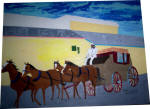
Stagecoach Mary
Portrait by Robert Grant
Story researched by Bryan Zepp Jamieson
Mary Fields, b. 1832, d 1914
A favorite device in television shows and paperback novels is to have a character whose personality utterly belies the profession and/or demeanor of the character involved. Thus, you get the creche girl with the heart of gold, the one-eyed hard-boiled sheriff who turns to mush over a kitten, the drunken cowhand with the third-grade education who can sing all of Verdiís operas from memory, in key, and in the original Italian.
It can get pretty silly.
Real life, of course, can beat fiction any day of the week. Which is why this article is about a woman who worked in a convent but who wore menís clothes, swore like a fishmonger, bellied up to the bar with the toughest of them, and threatened to (and sometimes did) kick the pills off any man who gave her any cause for annoyance. She really existed. She wasnít a Hollywood gimmick.
"Stagecoach" Mary Fields, sometimes known as "Black Mary" was born into slavery sometime in 1832, in Hickman County, Tennessee. If the circumstances of when she became a slave are unclear, the circumstances of how she left it are even less clear. Some say she escaped during the Civil War and made her way to Mississippi. Others say that she was one of many freed Blacks who left the south seeking employment in the north and west following passage of the 14th amendment.
Mary worked as a chambermaid aboard the legendary stern-wheeler, the Robert E. Lee. She was there for the legendary race against the Nanchez.
But in after a few years, she went up to Ohio to work in a mission school run by the Catholics and overseen by an old school friend, a woman by then known as "Mother Amadeus". Mary went to work for Amadeus doing odd jobs around the convent
Amadeus was posted to the remote outpost of Cascade, Montana, a railroad town between Helena and Great Falls. Stagecoach Mary elected to remain with the convent in Ohio, but in 1885, Amadeus contracted pneumonia and asked Mary to come tend to her. Mary complied, and a legend was born.
After Amadeus recovered, Mary elected to stay, and drive the stage the convent used to transport visitors and supplies between the train station and the convent. She did this at all hours of the day or night, in any weather or any season, and battled blizzards, wolves, and being stranded in bitter cold by overturned coaches.
While the convent made dutiful efforts to shave some of the rougher edges off of Mary, they were in vain. She chomped cigars, got into bar fights (with ranchers and loggers and muleskinners, and whatís more, she usually won), dressed like most of the hard-working men in the district, and used what was referred to back east as "indelicate language". She could tell tall tales in the bar, and was handy with rifle and handgun.
While this wasnít the sort of behavior the convent wanted to encourage, the fact was, she was far too valuable to them for them to raise much of a fuss. In addition to driving the stage, she did all the laundry, looked after hundreds of chickens, did acres of gardening, and once even killed a skunk with her bare hands that was threatening the chickens, apparently without getting doused in skunk oil. There are rumors of gun battles, as well.
But then she got into a dispute with a ranch foreman over some rigging, and wound up clouting the fellow in the head with a rock. He lived, but it was a bit too much for the local Bishop. He ordered Mary out.
The convent, unwilling to lose her but unable to defy church authority, did an end-run by moving her off the convent grounds and into her own place in Cascade, set her up with her own wagon and team of horses, and helped her to establish herself as the second female manager of a mail route.
She did this for eight years, braving blistering heat and blizzards and once sustaining serious injuries when her team got away from her.
In 1903, Sister Amadeus was transferred to Alaska, and "Stagecoach Mary", discouraged at the loss of her closest friend, gave up the mail route.
She took laundry to make ends meet, and made a couple of stabs at running a restaurant, but both times her own generosity did her in. She also babysat the local kids, including future star Gary Cooper, but tended to spend the proceeds from that on candy for the kids.
She would do anything for her friends, but was murder on anyone who crossed her. At the age of 70, she threw a roundhouse punch and decked a man who had stiffed her on her laundry bill.
The town, however, supported her in return for her hard work and many kindnesses. The local hotel provided her with free meals, and when her home and business burned down in 1912, the town rebuilt them, free.
Mary crawled off into the brush to die in 1914, but some of the adults who she had baby sat as children found her and took her to a hospital in Great Falls, where she died a few days later. Her funeral was one of the best-attended in memory.